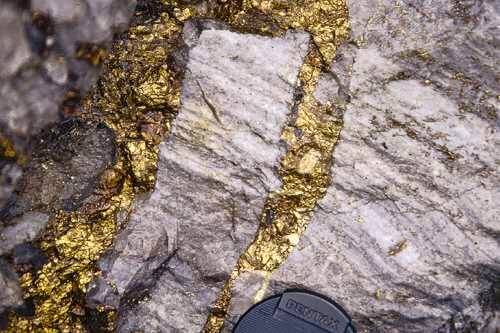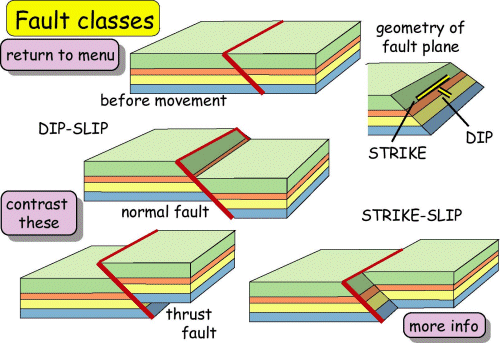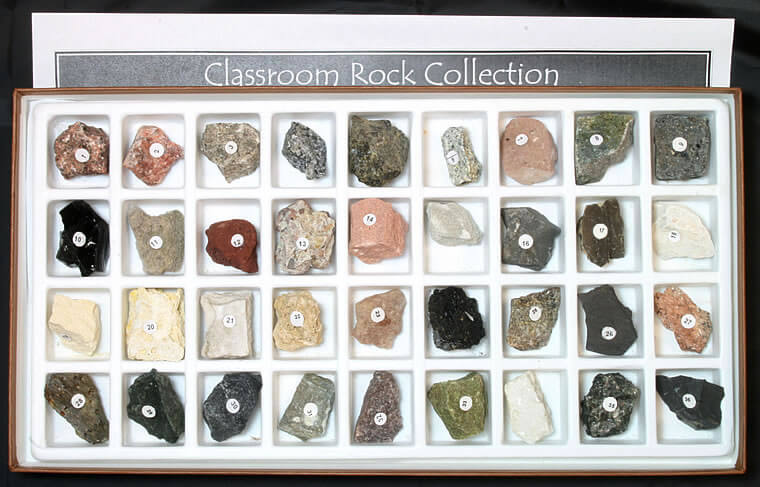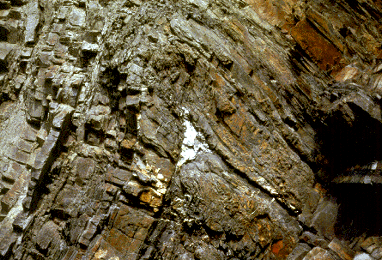Table of Contents
- Veins
- Joints
- Faults
- Shear Zones and Crush Zones
- Cause of Fractures
- Direction of Fractures
- How Minerals Deposit in Veins
- Depths at which Veins Have been Formed
- Veins Formed near the Surface
- Veins Formed at Moderate Depths
- Veins Formed at High Temperatures
- Zones of Mineral Deposits
- Saddle Reefs
- Shear Zones and Crush Zones
- Chimneys and Stocks
- Fahlbands
- Contact Metamorphic Deposits
Vein Mineral Deposits includes a considerable variety of ore deposits formed under various conditions by the concentration of the ore from the molten rock in process of cooling, and its subsequent deposition in fissures and joints, crevices, and pores; or the accompanying solvents make room for the ore by dissolving the rock and carrying it away.
It is thought that a great many veins and other ore bodies have been formed from the molten rock by separation of the minerals along with water and other substances that tended to keep the mass in a liquid state until it was pushed into a position where the cooling caused it to become solid. These substances, water, hydrochloric acid, hydrofluoric acid, boracic acid, etc., are often called mineralizers.
Veins
A vein is a mineral mass of a tabular form, deposited in a rock fracture. In shape, a vein is like a dike, but dikes are made of rocks. The name veins is reserved for mineral bodies of a different composition from rocks. By tabular is meant having two long dimensions and one short dimension, the length and depth of the vein being the long dimensions, and the width the short one. Country rock, or country, is the rock on each side of the vein.
The dip of a vein is the angle it makes with the horizontal, measured at right angles to the strike. The strike is the direction of the vein horizontally.
The walls are rock boundaries of the vein on each side. If the vein is sloping, the upper wall is called the hanging wall, and the lower the foot wall; but when the vein is vertical (dips at 90°) there can be no distinction.
Gouge or selvage is soft or shaly material on the walls of veins, due probably to grinding movements of the two surfaces on each other. This sometimes causes a polished surface, slickensides.
A druse or vug is an unfilled part of a vein; it is usually lined with crystals that project inward. Vein matter is the mineral mass filling the vein; it may or may not be valuable. The whole may be of value, for example, fluorspar and barite veins. Or the value may be in minerals like gold, silver, copper, and other ores scattered through quartz, calcite, or other mineral forming the main part of the vein matter, the gangue.
The material deposited in veins, etc., was forced upwards through and into weak places in the rocks, taking the path of least resistance, rather than through the more solid masses of rocks. The weak places are of various kinds and due to different causes. In some cases, the rocks themselves are structurally weak, for example, schists and some other metamorphic rocks. In other cases, the rock though structurally strong may have had weak places developed.
Joints
All rocks are cracked by small breaks, which are usually in roughly parallel sets that cross, and thus form intersecting channels. These breaks, called joints, are due to a number of causes; for example, shrinkage of the rocks by cooling or drying. Joints are more numerous near the surface than they are at greater depths.
Faults
A break of greater extent is called a fault if there has been displacement, as there usually is; but if there be no displacement, the word fault cannot be used. A fault is not usually one break, but quite commonly a main break, flanked on each side by a zone of smaller fractures; and it is common experience that these zones are the more favorable places for ore-deposits. But ore bodies are sometimes found in the main break. Faults are often marked by long cliffs. In some regions, there are sets of parallel fissures, sometimes one set crossing another. It is important to study the directions of these fissures, as the fracturing may have taken place at different times; and some fractures may be accompanied by ore deposition and others not.
Shear Zones and Crush Zones
These are bands of rock in which many fractures have been formed by a twisting or shearing movement, or in which the rock has been brecciated by such disturbances. Shear zones sometimes induce the deposition of valuable ore deposits. They are often of great width, and sometimes have clearly defined walls The ore may be deposited in the crevices only, or the rock may be penetrated or replaced by the valuable minerals, so as to give value to the whole zone.
Cause of Fractures
Fractures are found mostly in disturbed folded regions; pressure and tension due to folding and warping explain the breaks. It is believed that the pressure, at least in a great many cases, has been caused by the push of the intrusive liquid that formed the rocks with which so many ore deposits are associated. The fact that ore deposits are more common in rough country is explained by the connection between folding and breaks. As the folding and warping set up pressures and tensions slowly and in a definite, regular way, parallel systems of fractures are apt to be developed, as has been shown by applying similar forces to a strip of glass covered with brittle wax. Similar torsion cracks are often seen in rocks.
Direction of Fractures
The direction of a fracture is likely to be straight in solid uniform rock. In a stratified rock, the fracture is apt to run across the strata, as, for example, in sandstone and limestone; but in loose rock, like shale, slate or schist, it is more likely to run with the layers or cleavage. A strong fracture in passing from a dense, hard rock into shale or schist may change its direction and die out.
Relation of Veins to Igneous Intrusions.—The mineral deposits of the vein class may be conveniently studied in two divisions:
A. Veins, etc., near intrusions of igneous rock.
B. Veins, etc., apparently independent of igneous intrusions.
VEINS, ETC. NEAR INTRUSIONS OF IGNEOUS ROCKS
How Minerals Deposit in Veins
Mineral Deposits Connected with Intrusive Igneous rocks: Mineral deposits of this class must often have been formed at great depths and at relatively high temperatures and pressures. Since their deposition, they have been brought within our reach by erosion. It is believed that the ore has been deposited by hot liquids derived from the intrusive rock in the process of cooling and solidifying. In this liquid had been concentrated various minerals, including the valuable ones, all kept liquid by the presence of water and other solvents after the greater part of the intrusive rock had perhaps become solid. The quantity of solvents may have been relatively quite small. Under the high pressure and temperature, the minerals and solvents were kept as one liquid capable of flowing as a whole. This liquid found its way upward through channels of various kinds. In some cases it may have solidified without much change in composition, just as a rock dike is formed. In others it may have deposited certain minerals, and then passed on to deposit the remainder in another place. In successive stages, the same body of liquid may have thus formed a number of different kinds of deposits. It is common experience to find in the same vicinity barren quartz veins and others that carry gold. Sometimes veins have been invaded by later material that has been deposited in the cracks, often converting an otherwise valueless material into a valuable ore-body. These successive waves of liquid may have come from the same large body of intrusive rock, and it is quite easy to understand how some of the already formed veins of quartz, calcite, etc., more completely cracked up than others, might allow the enriching fluid to penetrate.
For prospecting purposes, it is important to know a great many details of the connections between mineral deposits and igneous intrusive rocks that have not only supplied the valuable concentrates but have also prepared their upward path by weakening the surrounding rocks. The intrusive rock itself sometimes affords this path by cracking as it cools. Another favorable place for mineral deposits is the contact between the igneous intruder and the rocks through which it has broken.
The ore may have been deposited in fissures by pressing into, and simply filling the spaces, but generally the solvents have penetrated the wall-rock more or less, removing it or filling it with other minerals, sometimes of value. In the same way joints, shear fractures, and other crevices have been enlarged, and sometimes the crushed rock has been completely removed and replaced by ore; it is plain that a well-fractured rock of porous texture is most favorable for this process. Another favorable condition is schisting of the rock next to the vein. That minerals may be carried in this way is sufficiently proved by the presence of lead, zinc, arsenic, gold, and other constituents of ore-minerals in the water of hot springs, and in the limey and siliceous sinter deposited by hot water.
Depths at which Veins Have been Formed
The mineral deposits connected with igneous intrusions have been formed at different depths, varying from probably only a few hundred feet from the surface down to depths of several miles. The nature of the deposit depends on the temperature at which it has been deposited, and this has been dependent, in a general way, upon the depth. It is usual to classify these deposits in three classes according to the depth at which they are supposed to have been formed.
Veins Formed near the Surface
This includes those formed at depths down to about 3000 or 4000 ft. The temperatures would be around 150° Centigrade. They are found principally in volcanic regions, and are the source of a large part of the world’s production of gold, silver, and mercury. Stibnite deposits are found, and some large deposits of lead and zinc ores belong to this class, but copper ores are not found plentifully. Although pyrite is scattered through such deposits, no large deposits of pyrite can be included. High temperature minerals, such as pyrrhotite, magnetite, pyroxene, hornblende, olivine, biotite, tourmaline, topaz, garnet, and ilmenite, are absent. Quartz is plentiful, and is apt to be of amethyst color. It is usually fine- grained and often of the dull, chalcedonic variety. Tellurides often accompany the deposits of gold and silver, and may be the chief bearers of the precious metals.
Calcite, dolomite, fluorspar, and barite are sometimes the principal gangue minerals. The deposits are apt to be irregular. The complex sulphur-antimony-arsenic minerals are often more plentiful than the simple sulphides.
Veins Formed at Moderate Depths
The depths may be from 4000 to 12,000 feet, and the temperatures ranged from about 175° to 300° Centigrade. The characteristic high temperature minerals are absent. These deposits yield a large proportion of the world’s production of gold, and much of the silver, copper, and zinc. The deposits are more regular than those formed nearer the surface. Lead ore has usually been deposited farther away from the intrusive rock than have the deposits of gold, silver, and copper ores. Stibnite may be plentiful in deposits of this class, and tellurides are found in the gold deposits. In Nova Scotia, and at Timmins, Ontario, scheelite is associated with the gold ore. When quartz is the gangue mineral, it is milky or glassy, and is coarsely crystalline.
In the neighborhood of the ore bodies, sericite is very common. The dark rock-minerals have their iron changed into pyrite. Carbonates have been formed plentifully in rocks of the darker kind.
Silver-lead veins are important in this class. The common ore minerals are galena and tetrahedrite; next in importance is zinc blende. Galena and zinc blende may be so abundant that lead and zinc form the chief values. In the Slocan, British Columbia, district, the ore-bodies are found in slate that is intruded by granite, quartz porphyry, and lamprophyre. The silver veins of Cobalt, Ontario, and also those of Thunder Bay, Ontario, belong in this class.
Veins Formed at High Temperatures
These are mineral deposits formed at temperatures ranging mostly between 300° and 575°C., but in some cases as high as 1400°C. Under similar circumstances, these temperatures would imply greater depths than those at which the deposits of Classes I and II were formed—depths ranging from 10,000 feet downward. But the differences in temperature of formation may have also been due to different distances horizontally from the hot intrusive mass.
While the high-temperature minerals, pyroxene, hornblende, garnet, tourmaline, ilmenite, magnetite, pyrrhotite, etc., are almost absent from the other two classes of deposits, the deposits of this class are characterized by the presence of one or more of them. The high-temperature deposits include ores of gold, copper, iron, tin, tungsten, and arsenic, and much less commonly, ores of silver, lead, zinc, and antimony. In the gold mines of the Porcupine Camp, Ontario, pyrrhotite, tourmaline, and scheelite are characteristic. At Rice Lake, Manitoba, biotite is found in the rock next to the gold veins. In the gold- copper deposits of Rossland, B.C., magnetite, biotite, garnet, actinolite, and wollastonite are found among the gangue minerals. In the lead-silver-zinc deposits of Kootenav, B.C., the gangue minerals include garnet, diopside, actinolite, and biotite.
Zones of Mineral Deposits
Mineral deposits connected with igneous intrusives may be classified in three zones, according to temperatures of deposition. Gold values are found in the three zones; silver, lead, and zinc mostly in the upper two; copper in the lower two; and mercury in the top zone of lowest temperature. In practice, where gold, copper, lead, and zinc are found in the same area, the lead and zinc are apt to be found farther away from the igneous intrusive.
It is this horizontal arrangement in zones that is of interest to the prospector.
Depths at which Ore Bodies may be Formed
The ascending stream of ore material may have deposited ore at depths of at least two or three miles, and from that upward.
Fissure Veins
These are ore bodies bounded by rather regular, straight walls, of fairly constant width, and with a definite direction of strike and dip; this gives a roughly tabular shape to the ore body. But the original fissure may have been irregular, with expansions and contractions due to displacements of irregular walls by faulting.
The ore body has sometimes been formed partly by filling the fissure and partly by replacing the wall-rock with ore, or by filling its pores with ore minerals to such an extent as to give it value. In this way, a large ore body—a replacement vein— may have been formed about a fissure originally very narrow. The outcrop of such an ore body may be very unattractive, showing only a thin streak of quartz or other gangue. But the altered condition of the rock on each side of the break, and its mineralization, are indications of ore deposition.
A lode is a number of parallel fissure veins, the rock between being sometimes mineralized, so as to form a continuous ore body. A vein system is a larger collection of fissure veins, often with cross veins connecting them. A bedded vein is one that follows the bedding of a stratified rock. Such ore bodies may be in the form of a succession of lenses, sometimes overlapping.
Saddle Reefs
The tension in the rocks of an anticline often causes fissures and also a separation of the layers of stratified rock, or at least so weakens the rock as to allow liquids ascending under pressure to press in and make room for ore deposits. Anticlines are therefore favorable places for ore-deposition. The ore may not only fill the fissure that breaks through the strata (where the rock is a stratified one) but it may also be deposited between the strata as a saddle-shaped orebody, called a saddle reef. The space for the ore may have been greatly enlarged, the solvents carrying away the rock in solution, and leaving ore in its place in the rock; and this is particularly likely to be the case with limestone. The outcrop of such an ore-body may be very inconspicuous.
Ore is sometimes deposited in the apex of an anticline, when there is a layer of tight rock above that stops the flow upward; the ore gathers under this layer. A very favorable situation is where a cross fold has caused a dome-shaped structure in the rock.
As the country is usually folded into a number of parallel folds, when an ore-body in found in one anticline, others should be looked for in a similar situation in all anticlines. This is well shown in the gold districts of Nova Scotia, where the anticlines are unusually regular and well formed. In the older formations of Ontario and Quebec, the evidence of anticlines and similar structures is often rather obscure.
Shear Zones and Crush Zones
Shear Zones are caused by a movement of the rock that results in many small fractures, somewhat regularly placed, and forming a system of channels very favorable for ore deposition, because the liquid moves slowly, allowing time for the necessary changes. When the rock has been extensively broken, it is called a crush-zone. There are sometimes fairly distinct walls between the sheared or broken rock and the more solid rock outside the zone. The rock within the zone may be more or less completely replaced by ore.
Chimneys and Stocks
A chimney is an ore body of a roughly circular shape in cross section, and extending downward to a considerable depth. A stock is an irregular mass of rock with a network of veins and veinlets. The rock between the veins may be mineralized, so that the whole body may be mined as ore.
Fahlbands
A fahlband is a belt of rock, usually schist, with pyrite, copper pyrites, and other minerals scattered through it, not usually rich enough to work; but workable veins may be found near or in the fahlbands. Disseminated deposits are somewhat like fahlbands, but may occur in igneous or sedimentary rocks; they are sometimes workable.
Contact Metamorphic Deposits
These are irregular ore bodies in the metamorphic (altered) zone of sedimentary rocks, mostly at or near their contact with igneous intrusive rocks. Igneous intrusives in schists and in older igneous rocks do not alter them very much. Limestone or limey shales are the usual sedimentary rocks. The altered zone may be a mile or two wide, but it is usually much narrower. The igneous rocks are sometimes of the acidic class, such as granite, though more commonly of the intermediate class, such as diorite, and, syenite. Gabbro is the intrusive at the Nickel Plate Mine, B. C. The ore has been deposited by hot solutions from the igneous rock, by a process of penetration and replacement, the rock having been more or less dissolved and carried away and the ore deposited in place of it. Most of these deposits are at the contact with the igneous intrusive or within a few yards of the contact, but some are much farther away. Sometimes the ore is in bunches, forming a belt around the igneous rock. Sometimes large bunches extend into the limestone, following fissures, sometimes as far as 2000 feet. There is often a maximum development of ore around blocks of limestone surrounded by the igneous rock, or around points of limestone projecting into it. The minerals of the ore kind, in order of abundance, are pyrite, pyrrhotite, chalcopyrite, bornite, zinc blende, molybdenite, mispickel, and galena. Specular hematite, ilmenite, and magnetite are also found. The gangue minerals are garnet, tourmaline, vesuvianite, diopside, tremolite, wollastonite, etc., and plentiful coarsely crystallized calcite, dolomite, and ankerite. Graphite and corundum may be found at such contacts. These contact deposits are mostly small, but are sometimes large. Ores of iron, copper, zinc, and tungsten are the most common. Less common are ores of lead, gold, silver, and tin.
